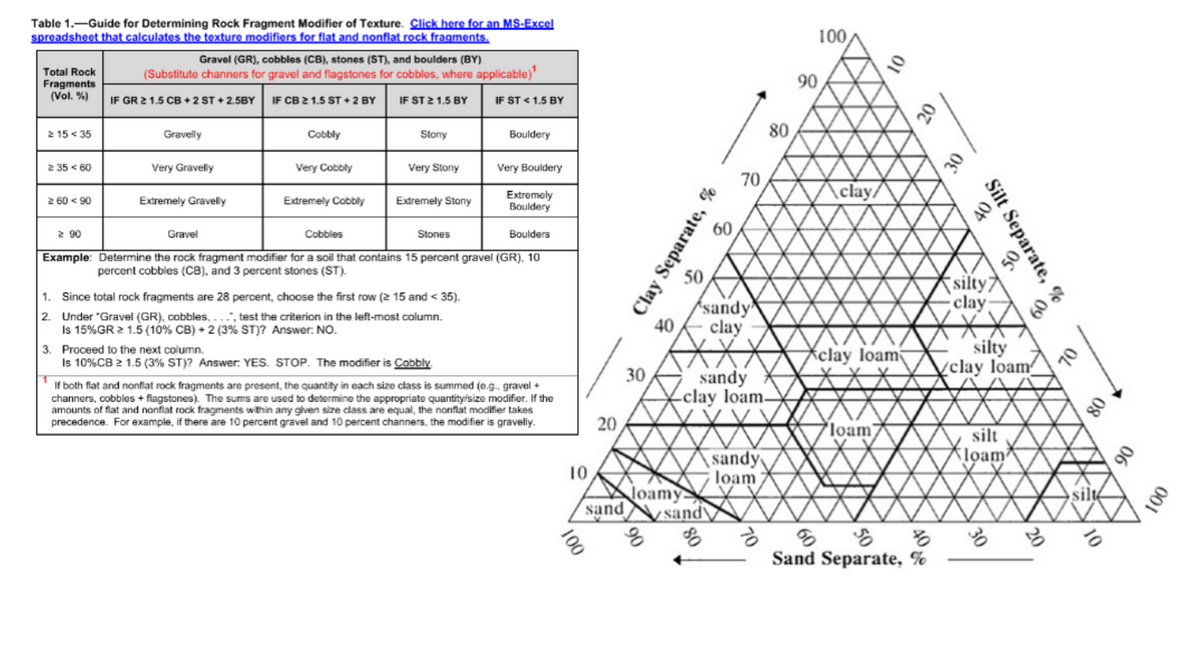A soil sample has the following size distribution; 4 to 2mm = 17%, 2 to 0.05 mm = 12%, 0.5 to 0.005 mm = 22% 0.005 to 0.002 mm = 10% <0.002 mm = 39% what is the percent clay silt and sand? What are the modifier and textural classification?
A soil sample has the following size distribution; 4 to 2mm = 17%, 2 to 0.05 mm = 12%, 0.5 to 0.005 mm = 22% 0.005 to 0.002 mm = 10% <0.002 mm = 39% what is the percent clay silt and sand? What are the modifier and textural classification?
Principles of Geotechnical Engineering (MindTap Course List)
9th Edition
ISBN:9781305970939
Author:Braja M. Das, Khaled Sobhan
Publisher:Braja M. Das, Khaled Sobhan
Chapter17: Subsoil Exploration
Section: Chapter Questions
Problem 17.12P
Related questions
Question
A soil sample has the following size distribution;
4 to 2mm = 17%,
2 to 0.05 mm = 12%,
0.5 to 0.005 mm = 22%
0.005 to 0.002 mm = 10%
<0.002 mm = 39%
what is the percent clay silt and sand? What are the modifier and textural classification?

Transcribed Image Text:Table 1.-Guide for Determining Rock Fragment Modifier of Texture. Click here for an MS-Excel
spreadsheet that calculates the texture modifiers for flat and nonflat rock fragments.
Total Rock
Fragments
(Vol. %)
21535
2 35 < 60
≥ 60 90
Gravel (GR), cobbles (CB), stones (ST), and boulders (BY)
(Substitute channers for gravel and flagstones for cobbles, where applicable)¹
IF CB 2 1.5 ST + 2 BY
IF ST 2 1.5 BY
IF ST < 1.5 BY
2.90
IF GR 2 1.5 CB+2 ST +2.5BY
Gravelly
Very Gravelly
Extremely Gravelly
Cobbly
Very Cobbly
Extremely Cobbly
Stony
Very Stony
Extremely Stony
1. Since total rock fragments are 28 percent, choose the first row (2 15 and < 35).
2.
Under "Gravel (GR), cobbles,..., test the criterion in the left-most column.
Is 15% GR 2 1.5 (10% CB) + 2 ( 3 % ST) ? Answer: NO.
Bouldery
Gravel
Cobbles
Stones
Boulders
Example: Determine the rock fragment modifier for a soil that contains 15 percent gravel (GR), 10
percent cobbles (CB), and 3 percent stones (ST).
3. Proceed to the next column.
Is 10% CB 2 1.5 (3% ST)? Answer: YES. STOP. The modifier is Cobbly.
Very Bouldery
Extremely
Bouldery
If both flat and nonflat rock fragments are present, the quantity in each size class is summed (e.g.. gravel +
channers, cobbles + flagstones). The sums are used to determine the appropriate quantity/size modifier. If the
amounts of flat and nonflat rock fragments within any given size class are equal, the nonflat modifier takes
precedence. For example, if there are 10 percent gravel and 10 percent channers, the modifier is gravelly.
10
100
20
30
40
SO
Clay Separate, %
60
70
sandy
clay
XXX
sandy
-clay loam-
sandy
loam
loamy.
sand sandy
80
90
100
clay/
10
clay loam
loam
%
Sand Separate, %
30
Silt Separate, %
P
%0
E
silty7
clay
silty
clay loam
silt
Kloam
30
D
20
70
80
silt
100
Expert Solution
This question has been solved!
Explore an expertly crafted, step-by-step solution for a thorough understanding of key concepts.
This is a popular solution!
Trending now
This is a popular solution!
Step by step
Solved in 4 steps with 1 images

Knowledge Booster
Learn more about
Need a deep-dive on the concept behind this application? Look no further. Learn more about this topic, civil-engineering and related others by exploring similar questions and additional content below.Recommended textbooks for you

Principles of Geotechnical Engineering (MindTap C…
Civil Engineering
ISBN:
9781305970939
Author:
Braja M. Das, Khaled Sobhan
Publisher:
Cengage Learning

Principles of Geotechnical Engineering (MindTap C…
Civil Engineering
ISBN:
9781305970939
Author:
Braja M. Das, Khaled Sobhan
Publisher:
Cengage Learning